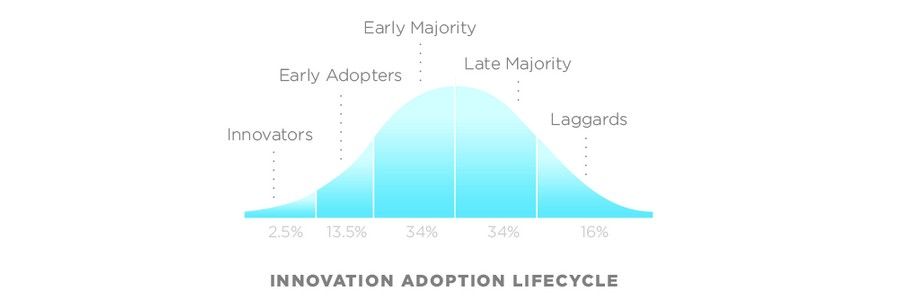Customer Adoption

Table of contents
What is Customer Adoption?
Customer adoption refers to the processes a business uses to win new customers. It also involves the onboarding of new customers who use an organization’s products and services.
In this context, customer adoption means assisting your customers in maximizing their potential enablement via guided implementation and effective use of your organization’s solutions.
Customer Adoption Curve
A customer adoption curve is a tool used by businesses to classify users into various categories based on their enthusiasm for new ideas and technology. It works by dividing consumers into the following five categories:
1. Innovators
2. Early adopters
3. Early majority
4. Late majority
5. Laggards

Image source: interaction-design.org
The customer adoption curve follows a bell-shaped arch that splits customer data into the five categories mentioned above. The basic data points show that people within the innovation category are most likely to adopt new technology first, but they have a small overall population at around 2.5%.
Customer Adoption Process
The customer adoption process is the mental course that an individual takes, from the breakthrough phase all the way to final adoption. It can also refer to the act or decision taken by a consumer to use a product on a regular basis.
Most buyers will have incredibly specific needs that require detailed analysis to be fulfilled. Those who decide to purchase in the early stages of a product’s life cycle are vastly different from those who decide to purchase a product later down the line.
Whilst certain groups may overlap, providing varied data points around demographics, they tend to have distinct buying behaviors and entirely different purchase motives.
Customer Adoption Rate & Metrics
The formula for measuring the customer adoption rate is:
Adoption rate = #of new users / #of total users
Adoption rates need to be calculated for specific time periods. For example, if you calculate an adoption rate for July, you would use the total number of users who used the feature for the first time, any day between July 1 and 31.
Significant improvement to a user’s experience can be gauged through software adoption metrics. For this to be achieved effectively, businesses must measure their success and set targets for the future.
Tracking progress, forming goals, and understanding the effects of change allow businesses to gradually and consistently improve both product and user adoption.
Customer Adoption Journey
The customer adoption journey can be explained in 5 easy steps:
1. Reach
This is the starting point of the customer journey. From a marketing standpoint, it’s important to track touchpoints that can help steer advertising campaigns or help businesses find out the most effective ways to drive brand awareness.
2. Acquisition
Initiating contact and turning potential customers into leads is what best defines the acquisition process. Interaction and engagement are key elements in defining potential customers.
But in the digital age, businesses are now going a step further and using specific consumer-targeted campaigns that are backed by oceans of data.
3. Conversion
When a customer releases a payment and begins using a product or service, they can be categorized into the conversion phase. The most important sales conversion metric is the conversion rate, which provides accurate percentages of leads who eventually turned into customers.
Conversion Rate = #of total sales / #of total leads X 100
4. Retention
The retention phase is a collective term for a number of smaller phases including, onboarding, support, adoption, engagement, and expansion. The idea here is to retain customer satisfaction by responding to challenges before they arise.
Engaging with customers regularly will ensure that you build a clear picture of consumer needs whilst simultaneously finding new and unique solutions.
5. Loyalty
Keeping track of customer reviews and ratings is essential in maintaining a healthy customer journey. However, loyalty also needs to be tracked through retention measures such as churn rate and renewal.
Referral programs and tracking can also be used to gauge a clearer picture of customer loyalty.
Customer Adoption Strategy
The objective of a customer adoption strategy is to help consumers reach a specific goal. Conducting vast amounts of research to understand their motivation, environments, beliefs, and needs are all important factors in determining why users haven’t adopted a product or service.
Perception also plays a big role in customer adoption strategies. Some users may decide to opt for a competitor’s product instead because they perceive your product to be too expensive. Understanding such nuances is vital in keeping and retaining customers in the long run.
What is Customer Success Adoption?
The adoption stage is the biggest part of the customer journey. In this stage, a customer will become acquainted with a product or service and develop an overarching opinion based on use, perception, and engagement with your organization.
Successful adoption is measured by how effectively a customer’s needs are met through the use of your product or service.
Why is Customer Adoption Important?
Increasing product adoption enables customers to detect new items, elements, and features of existing products. It also allows customers to build rapport with your business—helping them feel connected to your brand and developing a long-term relationship.
SaaS businesses are particularly familiar with the value of product adoption because they often struggle with low retention rates and low user adoption. This keeps such companies constantly on the lookout for new and innovative ways to keep customers on board and engaged, thus enhancing user adoption value.
Customer Adoption Jobs
Customer adoption jobs are on the rise and have been for the last five years. The scaled increase in the number of customer adoption jobs can be directly correlated to the digital boom and the shift to big data. It’s now easier than ever for businesses to track and gather valuable customer information which they can then use to predict or maintain customers’ needs.
The following attributes need to be demonstrated to qualify for a customer adoption position:
- Technically savvy – It gives you the ability to relay information across departments in a language that is understood by the team members of each function.
- Problem-solving attitude – Having the awareness to identify customer needs and develop potential solutions can provide immense value to your organization.
- Emotionally intelligent – These roles require you to be in constant contact with customers and other stakeholders, so it is critical that you know how to adapt to others.
Customer Adoption Manager
Customer adoption managers are individuals who work to track, monitor, and engage with customers to fully understand their motives and needs. Being able to thoroughly comprehend this data is a huge asset to modern businesses.
Customer adoption managers are highly skilled in data analysis and can collate information and interpret it to provide valuable business to customer strategy advice. Without customer adoption managers in place, it would be difficult to gauge customer experience and highlight areas for improvement.
Customer Adoption Interview Questions
These are the top three questions that you’ll most likely be asked in your customer adoption interview:
- What is your approach to uncovering and working towards customer expectations, values, and desired outcomes?
- What measures would you take to prevent customer churn/create customer loyalty?
- How do you go about identifying and establishing rapport with individuals in various customer roles such as: executives, department managers, admins, power-users, team leads, and general users?
It’s best if you familiarize yourself with the above questions and think of unique answers that demonstrate your skills and ability to maximize your chances of successfully passing the interview.
Customer Adoption Salaries
Customer adoption professionals can earn upwards of $100,000 annually. The potential for industry growth is huge and specific skills relating to customer engagement are in high demand.
Conclusion
There has never been a more exciting and better time to get into the growing customer adoption sector. With year-over-year business growth and new technological innovations hitting the market on a regular basis, the need for customer adoption is at an all-time high.
In fact, with greater consumer awareness than ever before, customer adoption is now expected to grow exponentially in the next five years and businesses are starting to take note.